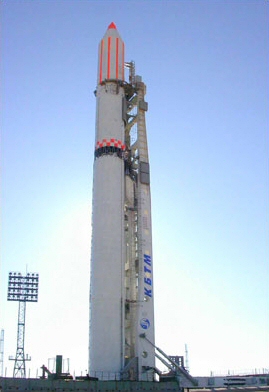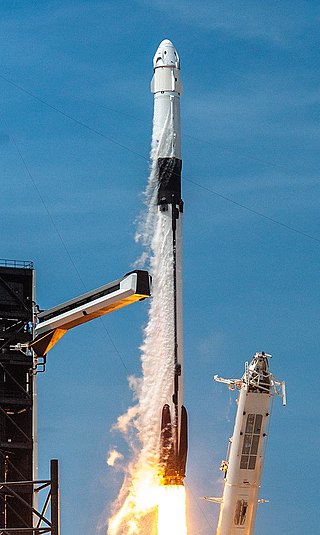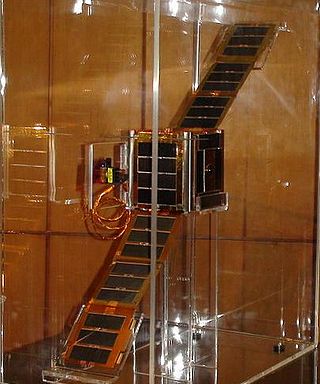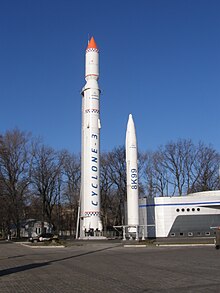
Proton is an expendable launch system used for both commercial and Russian government space launches. The first Proton rocket was launched in 1965. Modern versions of the launch system are still in use as of 2023,making it one of the most successful heavy boosters in the history of spaceflight. The components of all Protons are manufactured in the Khrunichev State Research and Production Space Center factory in Moscow and Chemical Automatics Design Bureau in Voronezh,then transported to the Baikonur Cosmodrome,where they are assembled at Site 91 to form the launch vehicle. Following payload integration,the rocket is then brought to the launch pad horizontally by rail,and raised into vertical position for launch.

Plesetsk Cosmodrome is a Russian spaceport located in Mirny,Arkhangelsk Oblast,near the town of Plesetsk,from which it takes its name. As of 2024,it is the only operational orbital spaceport in Europe and the northernmost spaceport in the world. Originally developed as an intercontinental ballistic missile (ICBM) site for the R-7 missile,its strategic location approximately 800 kilometres (500 mi) north of Moscow was key to its selection.
The Tsyklon,GRAU index 11K67,was a Soviet-designed expendable launch system,primarily used to put Kosmos satellites into low Earth orbit in the late-1960s. It is based on the R-36 intercontinental ballistic missile designed by Mikhail Yangel and made eight launches,with seven successes and one failure. All of its launches were conducted from LC-90 at the Baikonur Cosmodrome. It is sometimes designated Tsyklon-2A,not to be confused with the later Tsyklon-2 rocket. It was introduced in 1967 and was derived from the R-36 ICBM. It was retired in 1969.

The Angara rocket family is a family of launch vehicles being developed by the Moscow-based Khrunichev State Research and Production Space Center. The launch vehicles are to put between 3,800 kg (8,400 lb) and 24,500 kg (54,000 lb) into low Earth orbit and are intended,along with Soyuz-2 variants,to replace several existing launch vehicles.

The State Factory "Production Union Southern Machine-Building Plant named after O.M. Makarov",officially abbreviated as Pivdenmash and previously as Yuzhmash,is a Ukrainian state-owned aerospace manufacturer. Prior to 1991,it was a Soviet state-owned factory.

Blok D is an upper stage used on Soviet and later Russian expendable launch systems,including the N1,Proton-K and Zenit.

This comparison of orbital launch systems lists the attributes of all current and future individual rocket configurations designed to reach orbit. A first list contains rockets that are operational or have attempted an orbital flight attempt as of 2024;a second list includes all upcoming rockets. For the simple list of all conventional launcher families,see:Comparison of orbital launchers families. For the list of predominantly solid-fueled orbital launch systems,see:Comparison of solid-fueled orbital launch systems.
The Tsyklon-2,also known as Tsiklon-2 and Tsyklon-M,GRAU index 11K69,was a Soviet,later Ukrainian,orbital carrier rocket used from the 1960s to the late 2000s. The rocket had 106 launches,one suborbital and 105 orbital,with only one failure and 92 consecutive successful launches,from 27 December 1973 with the launch of Kosmos 626 to 25 June 2006 with the final flight of the Tsyklon-2,which makes this launcher most reliable within rocket launched more than 100 times.

The Long March 4A,also known as the Changzheng 4A,CZ-4A and LM-4A,sometimes misidentified as the Long March 4 due to the lack of any such designated rocket,was a Chinese orbital carrier rocket. It was launched from Launch Area 7 at the Taiyuan Satellite Launch Center. It was a three-stage rocket,used for two launches in 1988 and 1990. On its maiden flight,on 6 September 1988,it placed the FY-1A weather satellite into orbit. On its second,and final,flight it launched another weather satellite,FY-1B.

The Ecuadorian Civilian Space Agency is a private Ecuadorian organization founded in 2007 that conducts research on space and planetary sciences. It is a non-profit non-governmental organization with civilian oversight.

The Tsyklon-4,also known as Tsiklon-4 and Cyclone-4,was a Ukrainian carrier rocket which was being developed for commercial satellite launches. Derived from the Tsyklon-3,it had a new third stage,a larger payload fairing,and a modernised flight control system compared to its predecessor. The control system had been developed by JSC Khartron.
Strictly speaking,a satellite collision is when two satellites collide while in orbit around a third,much larger body,such as a planet or moon. This definition is typically loosely extended to include collisions between sub-orbital or escape-velocity objects with an object in orbit. Prime examples are the anti-satellite weapon tests. There have been no observed collisions between natural satellites,but impact craters may show evidence of such events. Both intentional and unintentional collisions have occurred between man-made satellites around Earth since the 1980s. Anti-satellite weapon tests and failed rendezvous or docking operations can result in orbital space debris,which in turn may collide with other satellites.
Parus,also Tsyklon-B or Tsiklon-B and Tsikada-M,GRAU index 11F627,was a Russian,previously Soviet satellite constellation used for communication and navigation. As of 2010,99 Parus satellites had been launched,starting with Kosmos 700 in 1974. All launches had been conducted using Kosmos-3M carrier rockets,flying from sites 132 and 133 at the Plesetsk Cosmodrome.

NEE-01 Pegaso is an Ecuadorian technology demonstration satellite,and Ecuador's first satellite launched to space. Built by the Ecuadorian Civilian Space Agency (EXA),it is a nanosatellite of the single-unit CubeSat class. The spacecraft's instruments include a dual visible and infrared camera which allows the spacecraft to take pictures and transmit live video from space.
The Blok DM-03,is a Russian upper stage used as an optional fourth stage on the Proton-M and Angara A5 heavy-lift rockets. Three have been launched,the first in December 2010;the first two launches failed before fourth stage ignition,the first as a result of a problem with the Blok DM's fuel load. Some versions are also known as Orion.
NEE-02 Krysaor is an Ecuadorian technology demonstration satellite,and Ecuador's second satellite launched to space. Built by the Ecuadorian Civilian Space Agency (EXA),it is a single-unit CubeSat nanosatellite. Krysaor is a Pegasus-class spacecraft,a "twin" of Ecuador's first satellite,NEE-01 Pegaso. Like Pegaso,this spacecraft's instruments include a dual visible and infrared camera which allows the spacecraft to take pictures and transmit live video from space.
A medium-lift launch vehicle (MLV) is a rocket launch vehicle that is capable of lifting between 2,000 to 20,000 kg by NASA classification or between 5,000 to 20,000 kilograms by Russian classification of payload into low Earth orbit (LEO). An MLV is between small-lift launch vehicles and heavy-lift launch vehicles.
The RD-855 (GRAU Index 8D68M),also known as the RD-68M,is a liquid-fueled rocket engine with four nozzles. As a vernier engine,it provides fine steering adjustments for rockets. It is powered by a combination of N2O4,an oxidizer,and UDMH,a propellant. This combination is hypergolic,meaning the two substances ignite on contact,eliminating the need for an external ignition source.

The Cyclone-4M is a Ukrainian carrier rocket which is being developed for commercial satellite launches.

Sich-1M was a Ukrainian spacecraft,constructed for remote sensing of Earth.














